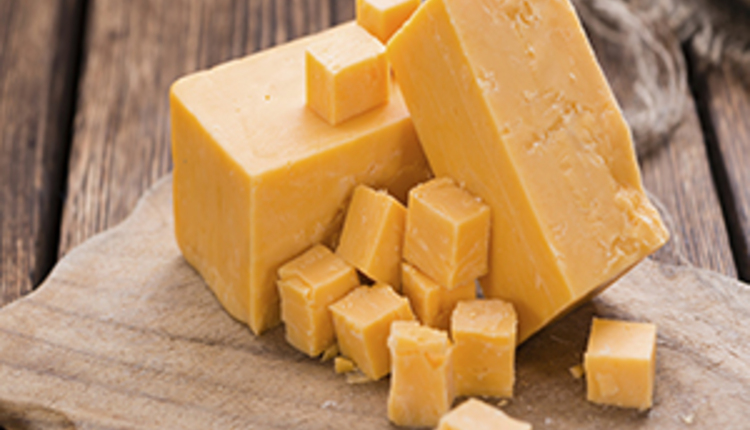
April 2025 is the latest month for which cheese price, cheese production, and cheese exports are all available. There were four NDPSRs released for April (Figure 1). The resulting weighted block price was $1.7117 per pound, and the weighted barrel price was $1.7244 per pound. Cheese price is set using the combined weightings, adding 3 cents to the barrel price, resulting in $1.7361 per pound for the April price. In this case, the volume of barrels was higher than blocks, so they carried more weight.
Butter | Blocks | Barrels | Whey | NFDM |
| ||||||
Date | Price | Volume | Price | Volume | Price | Volume | Price | Volume | Price | Volume | |
4/5/25 | 2.3603 | 3,441,106 | 1.7027 | 11,279,096 | 1.6633 | 14,851,496 | 0.5008 | 6,758,821 | 1.2079 | 15,229,830 | |
4/12/25 | 2.3396 | 3,551,079 | 1.6901 | 10,327,192 | 1.6835 | 14,250,643 | 0.5072 | 7,074,759 | 1.1902 | 19,607,226 | |
4/19/25 | 2.3701 | 3,779,440 | 1.7053 | 10,613,890 | 1.7397 | 14,184,079 | 0.4905 | 6,387,280 | 1.1700 | 20,480,341 | |
4/26/25 | 2.3390 | 4,026,500 | 1.7519 | 9,738,469 | 1.8263 | 12,475,192 | 0.4960 | 6,905,017 | 1.1559 | 26,649,032 | |
Figure 1. NDPSR for April 2025
New milk pricing formulas were introduced as of June 1, 2025, removing barrels from the NDPSR. These changes did not affect the April prices, but if they had been in place, cheese price would have been solely based on weighted block prices, at $1.711 per pound, resulting in a lower Class III price.
Cheese surveyed in the NDPSR is only a small fraction of total cheese production. Figure 2 contains the Dairy Products report for April cheese issued by USDA. Total cheese production was reported to be 1.23 billion pounds while block and barrel cheese in the NDPSR represented only 97.7 million pounds or 7.95% of total cheese. If we consider only Cheddar production at 388 million pounds, blocks and barrels in the NDPSR represented 25.2% of Cheddar production. Historically, Italian-type cheeses are the highest percentage of cheese produced at 43%, while Cheddar production represents approximately 28% to 30%. Not recognized in these percentages is the degree to which other cheese prices are based on either block or barrel prices. Removing barrels from the NDPSR in April would have lowered the surveyed cheese in the NDPSR to 3.4% for total cheese and to 10.8% for Cheddar cheese. It also reduced-price discovery value of the NDPSR for cheese and final producer class and component prices.

Figure 2. USDA Dairy Products. ISN 1949-0399
Another important aspect of the NDPSR is that the block price only represents yellow cheese. However, barrels are white Cheddar. See the definition of block cheese in Figure 3. The legacy of artificially coloring block cheese yellow dates to the 17th century to meet consumer expectations that yellow cheese is made from cows eating fresh green grass.

Figure 3. Definition of block cheese for the NDPSR
Almost all exported Cheddar cheese is white. In April, cheese exports (Figure 4) were about 109 million pounds, or 8.86% of production, of which Cheddar exports were 22.8 million pounds. With only yellow block Cheddar cheese in the NDPSR, almost all export prices will not be captured. However, it is worth noting that exports remove milk from the domestic supply chain, theoretically increasing NDPSR prices.The April Global Dairy Trade Auction cheese prices were $2.26 per pound while NDPSR reported a cheese price of $1.73 per pound. Granted there is cost to move cheese offshore, but the disparity in price is partly attributed to exports not being represented in the NDPSR. Under the old system, barrels were the only white Cheddar represented in the NDPSR.
April 2025 | ||
Product | Unit of measure | Quantity |
Cheese, All kinds | Metric ton | 13,431.30 |
Cheese, Inc Mixt | Metric ton | 12,099.10 |
Cheese, Fresh | Metric ton | 11,208.10 |
Cheese, Cheddar | Metric ton | 10,345.20 |
Cheese, Processed | Metric ton | 2,249.80 |
Cheese, Colby | Metric ton | 32.10 |
Cheese, Blue-VND | Metric ton | 26.30 |
49,391.90 | ||
Figure 4. April 2025 Cheese exports reported by USDA Foreign Agricultural Service
Price discovery for cheese has become narrowly focused on 40-pound yellow block Cheddar cheese while the industry is expanding production of other cheeses (i.e., white Cheddar for export, Italian-type cheese, and other non-Cheddar American cheeses). Due to the lack of broad price discovery, these other cheese types are often priced with a “basis” relative to block price. This basis is not reflected in Class III price. The situation can be best described as: milk is a commodity, and dairy producers are paid using the lowest common commodity (yellow block cheese) for Class III milk. Developing a system whereby dairy producers capture more of the value in cheese would need to be implemented on a regional basis as a cheese plant generating yellow block cheese would not be willing to pay more for Class III milk because another plant is producing a higher value cheese. This situation leads to another set of problems. Sometimes, you find yourself in a corner you cannot get out of easily.








